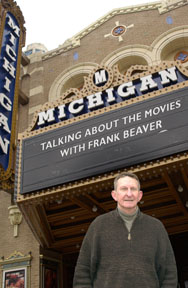MOVIES
When movie characters get intimate with the audience, that's
'direct-camera address'
By Frank Beaver

While watching the so-so Alfie remake starring Jude Law, I was reminded of just how startling, even off-putting, but ultimately effective the use of direct-camera address by a screen character can be.
Most films approach story and character development through varying degrees of objective-camera observation. Although the film may contain alternating long, medium and close shots, the camera appears to be an unnoticed recorder of the screen action. To maintain an objective point-of-view actors are usually positioned at an angle to the camera in order to avoid peering into the lens and calling attention to it.
So when a character intentionally addresses the camera, it is an unexpected conceit that carries all sorts of dramatic possibilities. In direct-camera blocking the actor openly “presents” himself or herself to the filmgoer—sometimes by simply looking at the camera lens. The glance shatters the objective distance between the viewer and the drama on screen.
This occurred with chilling effect in Ingmar Bergman's The Seventh Seal (1956) where Death, one of the principal characters, often looked directly into the camera lens as if to bring the viewer into an uncomfortable alliance with the life-death chess game taking place on screen.
A very intimate use of direct-address
can occur when a character openly acknowledges the
film audience and seeks to use the viewer as an accomplice
or confidant. Much of the enjoyment in Tony Richardson's Tom
Jones (1963) came through Albert Finney's winks
and shrugs to the audience after being caught in one
of his many mischievous capers. This rogue character
brought the viewer into interplay with the fun on screen
with his “So what!” responses to the camera.
In the case of Lewis Gilbert's Shirley
Valentine (1989) Pauline Collins, playing the
title role, talked incessantly to the audience, using
the viewer as a confidant as she reinterpreted her
life from rebellious teenager in high school to lonely
empty-nest wife in London to rebellious tourist in
Greece. Shirley Valentine's quirky presentational
style gave the film an unusual degree of personal
intimacy that viewers, male and female, found captivating.
And it brought the script's feminist message to forceful,
yet gentle life.
Alfie—in its original 1966
version with Michael Caine (also directed by Lewis
Gilbert) and now in its remake with Jude Law—uses direct-address
talk to convey a self-centered character whose easy-come,
easy-go way of life turns sour, very sour. Jude Law's
Alfie, more than Michael Caine's, is so camera-conscious
that nothing that enters this philanderer's mind's-eye
goes without some sort of lens interpretation.
Jude Law winks, ogles, shrugs, scowls,
smiles, frowns and spits out innuendoed one-liners—each
delivered with a quick turn to, then away from the
camera. The technique conveys a cad-about who is consumed
by physical self-awareness on his journey to new conquests
and, eventually, to personal come-uppance.
Direct-camera address is in part
a cinematic variation of the stage aside and it seems
to work especially well with spirited, self-obsessed
characters like Tom Jones, Shirley Valentine and Alfie.
The technique also seems to greatly benefit the film
actor. Albert Finney, Michael Caine, Pauline Collins
and now Jude Law gained in both popular appeal and
critical acclaim after their singular, tour-de-force
screen performances aimed right at the camera lens
and the viewer.
 Film historian and critic Frank Beaver is professor of film and video studies and professor of communication. Film historian and critic Frank Beaver is professor of film and video studies and professor of communication.
|


 Film historian and critic
Film historian and critic 